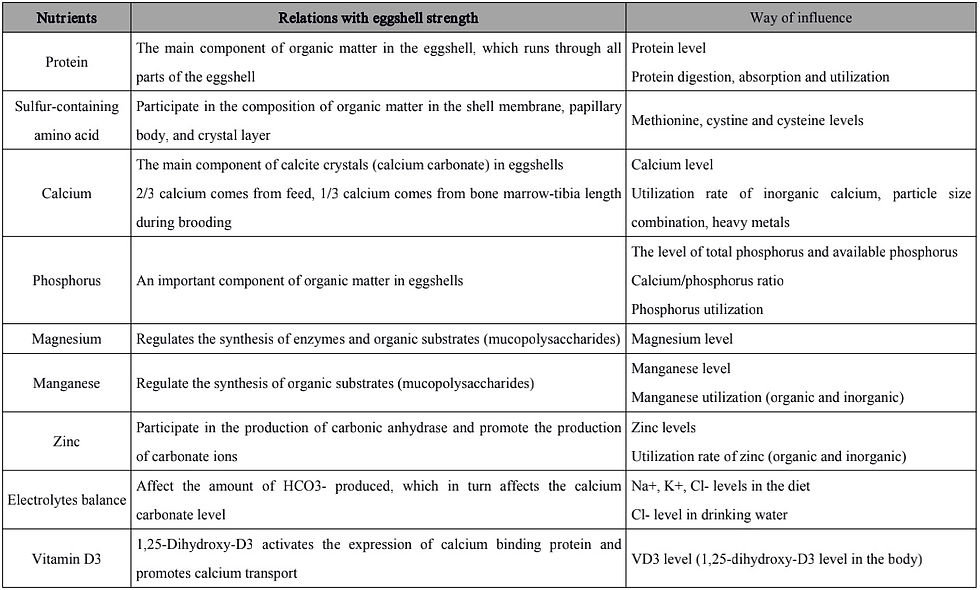360-degree analysis, explore on the key nutritional strategies to improve eggshell quality
- Christy

- Jun 7, 2021
- 3 min read
The eggshell quality problems have become increasingly prominent in scaled layer farms, mainly in the following aspects:
Current situation 1
Decreased egg shell strength has led to a high proportion of broken, soft and sand shell eggs (accounting for 3-5%)Current situation 2
The color of the eggshell becomes lighter (30-60%), which leads to poor sales and poor prices of eggs, especially branded eggs, with a kg unit price difference of 6-8 US cents.Current situation 3
Poor density of eggshells leads to short shelf life (decrease price for promotion, shelf life 14-15d on average, shorter in summer)Large-scale layer farms experienced serious economic losses due to poor eggshell quality:
From the sale of ordinary eggs: farms with 10,000 layers lose US$4,600 to US$9,500 per year due to a defective rate of 4-8% (eggshell quality problems)
For the sale of branded eggs: farms with 10,000 layers lose US$46,000 each year due to a defective rate of 20% (eggshell quality problems)
How to solve this problem?
The key is to understand the structure, formation process, and key participating substances of eggshells!
Structure and function of each section of eggshell

Formation of eggshell

Two effective measures to solve the shell quality problem:
a. Supply sufficient nutrients, such as protein, AA, minerals, vitamins, that is necessary for the synthesis of eggshell.
b. Ensure the normal structure and function of oviducts (isthmus and uterus)
Analysis on the factors that influence shell quality
1. Breed
Shell strength: brown shell > light brown shell; foreign varieties > domestic varieties. The utility of calcium differs among breeds, thus increasing calcium level in feed cannot change this relative differences.

Eggshell color is of high heritability (0.58-0.76). Modern commercial layers are chicken breeds that have been bred for a long time, and their eggshell colors are relatively fixed. However, whether the color of the eggshell becomes white, lighter, or shown pigmented plaques can be used as a very important indicator to monitor the health of the flock.
2. Day-old age
Shell strength increase with weeks from first laying, then decrease rapidly at late laying period, that is, from 50-55 week of age

Shell color: Protoporphyrin IX level stay low after 34 week of age. Thus, with the increase of shell superficial area, shell color becomes lighter.

3. Farm management
Stress: blood lactic acid ↑ → PH value ↓ → free calcium combined with protein and lactic acid respectively → blood calcium ↓ → egg shell quality ↓
Heat stress: corticosterone synthesized by the adrenal cortex ↑ → VD3 conversion in the kidney ↓ → Calcium absorption rate ↓ → Calcium excreted by the kidney ↑ → Calcium transport rate ↓ → Eggshell quality ↓
Shock: abdominal pressure ↑ → Fallopian tube contraction ↑ → Egg staying time in the uterus ↓ → Egg shell quality ↓
4. Disease
Infectious disease: Infectious laryngotracheitis (bronchitis, avian flu, Newcastle disease), egg drop syndrome, encephalomyelitis, etc.
Hepatic origin disease: fatty liver, common liver-derived diseases, especially diseases before 42 days of age, overweight (excessive) of laying hens and fatty liver
Inflammation of the fallopian tube: Both the quality of feed and drinking water will cause inflammation of the fallopian tube.
5. Nutrition factors
A、Shell strength

Shell color

Under the premise of certain species, age, feeding management, and disease status, the quality of eggshells can be improved through feed nutrition!
Essential nutrition strategies to improve shell quality
(1)Essential nutrients


(2)Essential nutrients that can improve eggshell color

(3)Enhance health of intestine and oviduct
Extra supplement of functional additives, such as bioactive peptides, essential oil, etc.
(4)Reduce pathogenic microorganisms, toxins, heavy metals, etc. brought into the diet
(5)Ensure the quality of drinking water
(6)Control E. coli and heavy metals not to exceed the standard
For the majority of layer farms, the quality of eggshells should not be underestimated! Only under the premise of good feeding management and disease prevention, can the improvement strategy of feed nutrition exert the greatest effect. Effective eggshell quality and nutrition improvement strategies need to achieve the following two aspects: ensure adequate supply of nutrients (protein, amino acids, minerals, vitamins) involved in the synthesis of eggshell structure; ensure a normal structure and function of the fallopian tube (isthmus and uterus) .








Comments